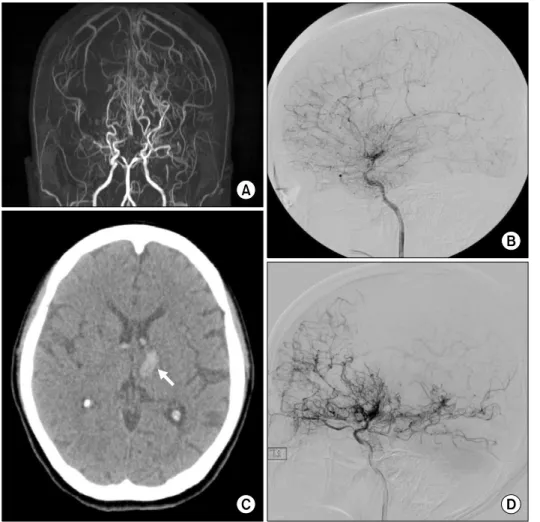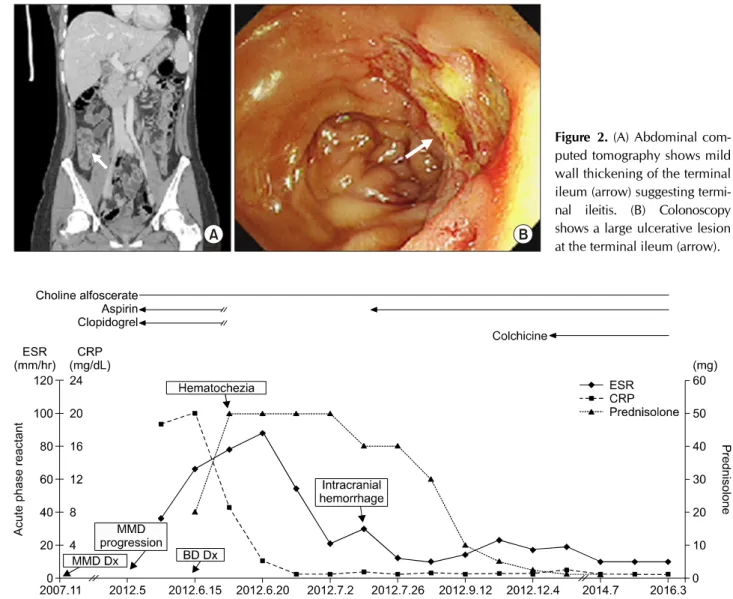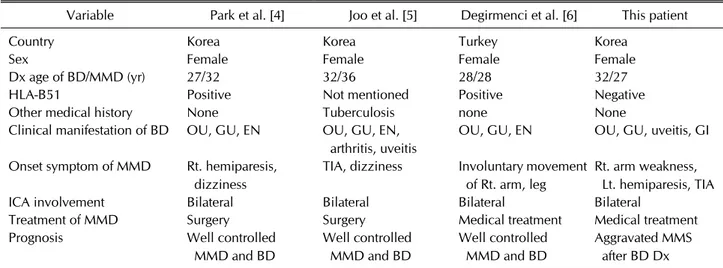Received:July 6, 2016, Revised:(1st) July 25, 2016, (2nd) July 27, 2016, Accepted:July 29, 2016
Corresponding to:Chan Hee Lee, Division of Rheumatology, Department of Internal Medicine, National Health Insurance Service Ilsan Hospital, 100, Ilsan-ro, Ilsandong-gu, Goyang 10444, Korea. E-mail:chanheell@daum.net
pISSN: 2093-940X, eISSN: 2233-4718
Copyright ⓒ 2016 by The Korean College of Rheumatology. All rights reserved.
This is a Free Access article, which permits unrestricted non-commerical use, distribution, and reproduction in any medium, provided the original work is properly cited.
Case of Moyamoya Disease Aggravated during the Treatment of Behçet’s Disease
Eun Seong Park1, Yoon-Jeong Oh1, Byung-Woo Yoo1, Sung Soo Ahn1, Jin Su Park2, Pyeong Ho Yoon3, Chan Hee Lee2
1Department of Internal Medicine, Yonsei University College of Medicine, Seoul, Departments of 2Internal Medicine and 3Radiology, National Health Insurance Service Ilsan Hospital, Goyang, Korea
Behçet’s disease (BD) is a multi-organ involved inflammatory disorder described by recurrent oral ulcers and other systemic manifestations. Almost all the clinical manifestations of BD are believed to be due to vasculitis. On the other hand, the cerebral arteries are rarely involved. Moyamoya disease (MMD) is an unusual chronic cerebrovascular disorder that is described by bi- lateral progressive stenosis or occlusion of the internal carotid artery and an abnormal collateral vascular network. A 32-year-old woman with MMD was referred for fever, oral pain, and diarrhea, and was diagnosed with BD. Her MMD was ag- gravated during treatment with high dose steroids to control the intestinal BD and a reduction in the MMD medication due to gastrointestinal bleeding. This is the first reported case of intestinal BD in a patient previously diagnosed with MMD, who expe- rienced aggravation of her MMD after the cessation of MMD medication due to aggravated intestinal BD. (J Rheum Dis 2016;23:386-391)
Key Words. Behcet syndrom, Intestinal Behçet’s disease, Moyamoya disease, Aggravated
INTRODUCTION
Behçet’s disease (BD) is a multi-organ involved in- flammatory disorder described by recurrent oral aphthae ulcers, genital ulcers, skin lesions, and systemic manifes- tations including vascular, gastrointestinal involvement, neurologic involvement, ocular disease, or arthritis.
Almost the whole clinical manifestations of BD are thought to be due to vasculitis [1]. It involves all sizes of blood vessels, and both artery and vein. However, the cer- ebral arteries are rarely involved.
Moyamoya disease (MMD) is a cerebrovascular disorder that is characterized by progressive stenosis or occlusion of bilateral internal carotid arteries and the formation of an abnormal vascular collaterals called “moyamoya ves- sels”. Moyamoya syndrome (MMS) is a term used to ex- plain moyamoya-like vessels related with other diseases [2]. Although the etiology of MMD related to auto-
immune conditions is unclear, an immunologic basis has been suggested, and recent studies have noted an associa- tion between MMD and autoimmune diseases, including Graves’ disease, diabetes mellitus, and systemic lupus er- ythematosus (SLE) [3].
Although there is a similarity between BD and MMD, which is characterized by vasculopathy, reports of cases of MMD accompanied by BD are very rare [4-6], and little is known about the association between the two diseases.
In this report, we present a rare case of a patient who was diagnosed with intestinal BD 5 years after MMD onset.
She developed intracerebral hemorrhage (ICH), which indicated MMD progression after cessation of MMD med- ication due to aggravated intestinal BD, and we controlled both diseases with medical treatment.
Figure 1. (A) Initial brain mag- netic resonance angiography shows stenosis of bilateral distal internal carotid arteries with well-developed basal and pial collaterals. (B) Initial left internal carotid angiography shows ste- nosis of the left distal internal carotid artery. Well-developed basal collaterals and pial collat- erals to the left hemisphere through the left posterior cere- bral artery are also seen. (C) Follow up brain computed to- mography shows a newly ap- pearing acute intracerebral he- morrhage in the left thalamus with extension to the ventricles (arrow). (D) On follow up cere- bral angiography, aggravated stenosis of the left distal internal carotid artery is seen.
CASE REPORT
In June 2012, a 32-year-old Korean woman was visited to the hospital with fever (up to 39.4oC), oral pain, and di- arrhea for 7 days. At age 27, in November 2007, she was diagnosed with MMD with manifestations of right arm weakness, left hemiparesis, and transient ischemic at- tacks (TIA) lasting for 2 months. At that time, brain mag- netic resonance angiography (MRA) and cerebral angiog- raphy revealed bilateral stenosis of the distal internal car- otid arteries (ICA) and A1 segment, and occlusion of the bilateral M1 segments with profound basal and pial col- laterals (Figure 1A and 1B). Brain single positron emis- sion computed tomography (CT) revealed decreased vas- cular reserve of the left cerebral hemisphere. She was di- agnosed with MMD and was given medical treatment (acetyl-L-carnitine and choline alfoscerate).
In May 2012, although she was recommended to under- go bypass surgery because of recurrent right arm weak- ness, which was thought to be associated with MMD progression. However, she refused surgery and main-
tained only medical treatment (aspirin, clopidogrel, chol- ine alfoscerate). Other medical history, drug history, and family history were unremarkable.
Upon admittance in June 2012, her mental status was normal but she had an acute ill-looking appearance. On admission, her body temperature was 38.0oC, systolic blood pressure was 132 mmHg, and pulse rate was 102 beats per minute. Physical examination revealed oral ul- cers, perianal ulcers (two 0.5×1.0 cm ulcers filled with yellowish granulation tissue on the right and caudal side), a genital ulcer (2×1 cm ulcer filled with yellowish gran- ulation tissue on the left labia major) and no other skin lesions. She complained of abdominal pain but there was no abdominal direct or rebound tenderness. The results of a neurological examination were unremarkable. Because of the bilateral ocular discomfort, an ophthalmic exami- nation was performed and revealed anterior uveitis in both eyes.
Laboratory examination revealed the following data:
leukocytosis (16,000/μL total white blood cell count), hemoglobin 12.4 g/dL, platelet 177,000/μL, erythrocyte
Figure 2. (A) Abdominal com- puted tomography shows mild wall thickening of the terminal ileum (arrow) suggesting termi- nal ileitis. (B) Colonoscopy shows a large ulcerative lesion at the terminal ileum (arrow).
Figure 3. Acute phase reactant level and medication according to the clinical course. ESR: erythrocyte sedimentation rate, CRP:
C-reactive protein, MMD: Moyamoya disease, BD: Behçet’s disease, Dx: diagnosed.
sedimentation rate 36 mm/h, and C-reactive protein (CRP) 18.72 mg/dL. Chemical analyses of serum were within normal limits. An infectious workup was negative for bacteria. Cultures of blood, urine, and sputum showed no growth of bacteria. Results of immunological analyses were as follows: immunoglobulin (Ig) G 1,284 mg/dL, IgA 188 mg/dL, IgM 166 mg/dL, C3 105 mg/dL, C4 48 mg/dL, human leukocyte antigen 51 negative, anti- nuclear antibody negative, rheumatoid factor negative, anti-neutrophil cytoplasmic antibody negative. Chest X-ray, electrocardiogram, and echocardiogram findings were all nonspecific.
Because of her abdominal pain and diarrhea, an abdomi- nal CT was performed and it showed mild wall thickening of the terminal ileum, suggesting terminal ileitis (Figure 2A). A colonoscopy showed a large well-demarcated ulcer
at the terminal ileum and several small ulcers in the colon (Figure 2B), which suggested intestinal BD. The pathol- ogy of terminal ileum revealed erosion and chronic in- flammation with lymphoid follicles and regenerative change. She was diagnosed with BD after meeting the cri- teria of recurrent oral ulcers, genital ulcers, and uveitis.
Because she had a fever and laboratory data showed CRP elevation, empirical antibiotics (flomoxef/clindamy- cin/gentamycin for 8 days) were started because of the probability of infection. She was also administered oral prednisolone 20 mg/day. Since her fever continued and hematochezia developed, we stepped up the antibiotics (piperacillin-sulbactam/metronidazole for 8 days) and prednisolone (50 mg/day, 1 mg/kg) and stopped the as- pirin and clopidogrel. Her hematochezia improved over the follow-up, and she was discharged on steroid therapy
Table 1. Clinical characteristics of Moyamoya disease (MMD)/Behçet’s disease (BD) coexistence cases
Variable Park et al. [4] Joo et al. [5] Degirmenci et al. [6] This patient
Country Korea Korea Turkey Korea
Sex Female Female Female Female
Dx age of BD/MMD (yr) 27/32 32/36 28/28 32/27
HLA-B51 Positive Not mentioned Positive Negative
Other medical history None Tuberculosis none None
Clinical manifestation of BD OU, GU, EN OU, GU, EN, arthritis, uveitis
OU, GU, EN OU, GU, uveitis, GI
Onset symptom of MMD Rt. hemiparesis, dizziness
TIA, dizziness Involuntary movement of Rt. arm, leg
Rt. arm weakness, Lt. hemiparesis, TIA
ICA involvement Bilateral Bilateral Bilateral Bilateral
Treatment of MMD Surgery Surgery Medical treatment Medical treatment
Prognosis Well controlled
MMD and BD
Well controlled MMD and BD
Well controlled MMD and BD
Aggravated MMS after BD Dx
Dx: diagnosis, HLA: human leukocyte antigen, ICA: internal carotid artery, OU: oral ulcer, GU: genital ulcer, EN: erythema nodosum, GI: gastrointestinal, Rt.: right, TIA: transient ischemic attack, Lt.: left.
at a dose of 1 mg/kg.
One week after discharge, the patient was readmitted with right side weakness and dysarthria that was ag- gravated after psychiatric stress. CT angiography showed newly appearing acute ICH in the left thalamus with ex- tension to the ventricles (Figure 1C) and cerebral angiog- raphy revealed bilateral occlusion of the distal M1 and A1 with profound basal collaterals, aggravated stenosis of the left middle cerebral artery (MCA), and bilateral ante- rior cerebral arteries (Figure 1D). This was thought to be because of progression of MMD. Steroid treatment was maintained and she was given conservative care for 2 weeks with aspirin and choline alfoscerate and was dis- charged without any evidence of BD or MMD progression.
Her symptoms had improved on her next follow-up and the steroids were tapered down over the next 6 months and colchicine was started (Figure 3). Currently (after 48 months of follow-up), she does not have any symptoms and is under observation on colchicine, aspirin, and chol- ine alfoscerate.
DISCUSSION
BD is a multi-organ involved inflammatory disorder and many clinical manifestations of BD are thought to be due to vasculitis [1]. Among the systemic vasculitides, BD is notable for its property to involve all sizes of blood vessels on both sides of the artery and vein of the circulation.
Arterial lesions are usually pseudoaneurysm or true aneurysms, which are the major causes of mortality in BD
patients [7]. However, cerebral arteries are rarely involved. BD is more common (and often more severe) along the ancient silk road, which extends from eastern Asia to the Mediterranean [1].
MMD is an unusual chronic cerebrovascular disorder that is described by progressive stenosis or occlusion of bilateral internal carotid arteries and branches of the Circle of Willis and is accompanied by the formation of a smoky angiographic appearance (fine and rich, but fragile and easy to rupture) of the collateral vascular network called “moyamoya vessels.” Its incidence is higher in East Asian countries such as Japan and Korea [2].
Both MMD and BD are common in Asia, especially east- ern Asia, and are related to genetic factors such as human leukocyte antigen genes. Along with an environmental similarity, these two diseases have a similar patho- genesis, which is supported by the association of in- fection and autoantibodies [8-10]. However, a claim of similar pathology or an incidental coexistence would be speculative.
MMS or quasi-MMD is a term applied to describe the de- velopment of Moyamoya vessels secondary to other path- ologies such as SLE, Down syndrome, atherosclerosis, neurofibromatosis, sickle cell disease, or others [3].
There have been several reported cases of MMD related with autoimmune diseases such as SLE. Only three MMD cases associated with BD have been reported (two from Korea, one from Turkey). These three cases and this case are detailed in Table 1.
Park et al. [4] made the first case report of BD associated
with MMD. The patient was a Korean woman who was di- agnosed with BD on the basis of oral ulcers, genital ulcers, erythema nodosum, and pathergy test positive 5 years ago, and admitted with right hemiplegia and dizziness at the age of 32. MRA revealed stenosis and occlusion of bi- lateral distal ICAs and MCAs (M1 segment) with basal rich collaterals, which suggests Moyamoya vessels. Right extracranial/intracranial arterial bypass surgery with en- cephalo-muscular synangiosis (EMS) was performed, and symptoms improved [4].
Joo et al. [5] reported a 32-year-old Korean woman who was diagnosed with BD on the basis of oral ulcers, re- current genital ulcers, erythema nodules, vasculitis, and arthritis 4 years ago, and was admitted with TIA and dizziness. MRA showed occlusion of both MCAs, and cer- ebral angiography showed occlusion of the supraclinoid portion of the internal carotid arteries with large basal vascular collaterals, suggesting MMD. The patient has had no further TIAs after a superficial temporal ar- tery-middle cerebral artery bypass with EMS [5].
Degirmenci et al. [6], described a case of a woman pre- senting with involuntary movement of her right arm and leg at the age of 28 and who had a medical history of BD as indicated by on recurrent oral ulcers, genital ulcers, and skin lesions. MRA revealed bilateral occlusion of the distal carotid arteries and basilar artery and rich vascular collateral circulation bringing out a smoky angiographic appearance was suggestive of MMD. Her symptoms fully resolved after intravenous hydration and bed rest [6].
All four cases including this case were young Asian women. Although the diagnosis of intestinal BD was made 5 years after the appearance of MMD in our case, other three cases were diagnosed with BD before the oc- currence of MMD or simultaneously.
In other cases, MMD was well controlled after bypass surgery or conservative care. However, this patient was readmitted due to MMD progression with newly devel- oped ICH during treatment with high dose steroids for the control of BD activity and a reduction in MMD medi- cation because of gastrointestinal bleeding.
This is the first reported case of MMD diagnosed before the appearance of BD and that showed progression of MMD despite ongoing BD treatment. Based on this pa- tient, we have two hypotheses about MMD progression.
First, it is possible that inappropriate treatment ag- gravates MMD. Although MMD treatment is controversial, a recent study demonstrated surgical intervention could prevent recurrent hemorrhage [11]. Our patient was rec-
ommended to undergo surgical treatment due to disease progression despite medical treatment, but she refused surgery. Also, stopping aspirin and clopidogrel due to re- current hematochezia could be associated with MMD progression.
Second, MMD may progress with increased BD disease activity. In cases associated with SLE and MMD, many hy- potheses and analyses indicate that MMD aggravation is correlated with disease activity; one case suggests that cessation of immunosuppressive therapy may result in the development of MMD [12]. If BD has a disease pat- tern similar to SLE, increased disease activity related to stressful events such as psychiatric stress could aggravate MMD. However, this is just speculation, and needs fur- ther study.
In this case, uncontrolled BD activity induces medi- cation cessation of MMD and affects MMD aggravation consequentially. Therefore, in a patient with these two diseases, proper disease control of BD and continuous treatment maintenance of MMD are important. Also, it is important to distinguish MMD aggravation and newly de- veloped neurologic involvement of BD in a patient with BD and MMD who is complaining neurologic symptom such as dysarthria, unilateral side weakness.
SUMMARY
We report a case of intestinal BD patient with MMD and describe an uncommon association of BD and MMD. We suggest there is a possibility of a similar pathogenesis of BD and MMD and formulated hypotheses about MMD aggravation. In a patient with BD and MMD, it is thought that proper and continuous treatment of these two dis- eases is important. Rare cases of association with MMD and BD have been reported and little is known regarding the relationship between the two diseases. Further stud- ies are necessitated to elucidate the relation between BD and MMD.
CONFLICT OF INTEREST
No potential conflict of interest relevant to this article was reported.
REFERENCES
1. Yazici H, Fresko I, Yurdakul S. Behçet's syndrome: disease manifestations, management, and advances in treatment.
Nat Clin Pract Rheumatol 2007;3:148-55.
2. Kim JS. Moyamoya disease: epidemiology, clinical features, and diagnosis. J Stroke 2016;18:2-11.
3. Chen JB, Liu Y, Zhou LX, Sun H, He M, You C. Prevalence of autoimmune disease in moyamoya disease patients in Western Chinese population. J Neurol Sci 2015;351:184-6.
4. Park YW, Chung JW, Yoon HJ, Yoon W, Kee SJ, Lee SS.
Behçet's disease presenting with clinical manifestations of moyamoya disease. J Korean Rheum Assoc 2005;12:227-30.
5. Joo SP, Kim TS, Lee JH, Lee JK, Kim JH, Kim SH, et al.
Moyamoya disease associated with Behcet's disease. J Clin Neurosci 2006;13:364-7.
6. Degirmenci E, Bir LS, Yagcı B, Nazliel B, Siva A. Moyamoya syndrome or Behçet's disease? Int J Rheum Dis 2014;17:
920-2.
7. Fei Y, Li X, Lin S, Song X, Wu Q, Zhu Y, et al. Major vascular involvement in Behçet's disease: a retrospective study of 796 patients. Clin Rheumatol 2013;32:845-52.
8. Han H, Pyo CW, Yoo DS, Huh PW, Cho KS, Kim DS.
Associations of Moyamoya patients with HLA class I and class II alleles in the Korean population. J Korean Med Sci 2003;18:876-80.
9. Inoue TK, Ikezaki K, Sasazuki T, Matsushima T, Fukui M.
Analysis of class II genes of human leukocyte antigen in pa- tients with moyamoya disease. Clin Neurol Neurosurg 1997;99 Suppl 2:S234-7.
10. Takeuchi M, Kastner DL, Remmers EF. The immunogenetics of Behçet's disease: A comprehensive review. J Autoimmun 2015;64:137-48.
11. Yamada S, Oki K, Itoh Y, Kuroda S, Houkin K, Tominaga T, et al. Effects of surgery and antiplatelet therapy in ten-year follow-up from the registry study of research committee on Moyamoya disease in Japan. J Stroke Cerebrovasc Dis 2016;
25:340-9.
12. Wang R, Xu Y, Lv R, Chen J. Systemic lupus erythematosus associated with Moyamoya syndrome: a case report and lit- erature review. Lupus 2013;22:629-33.


